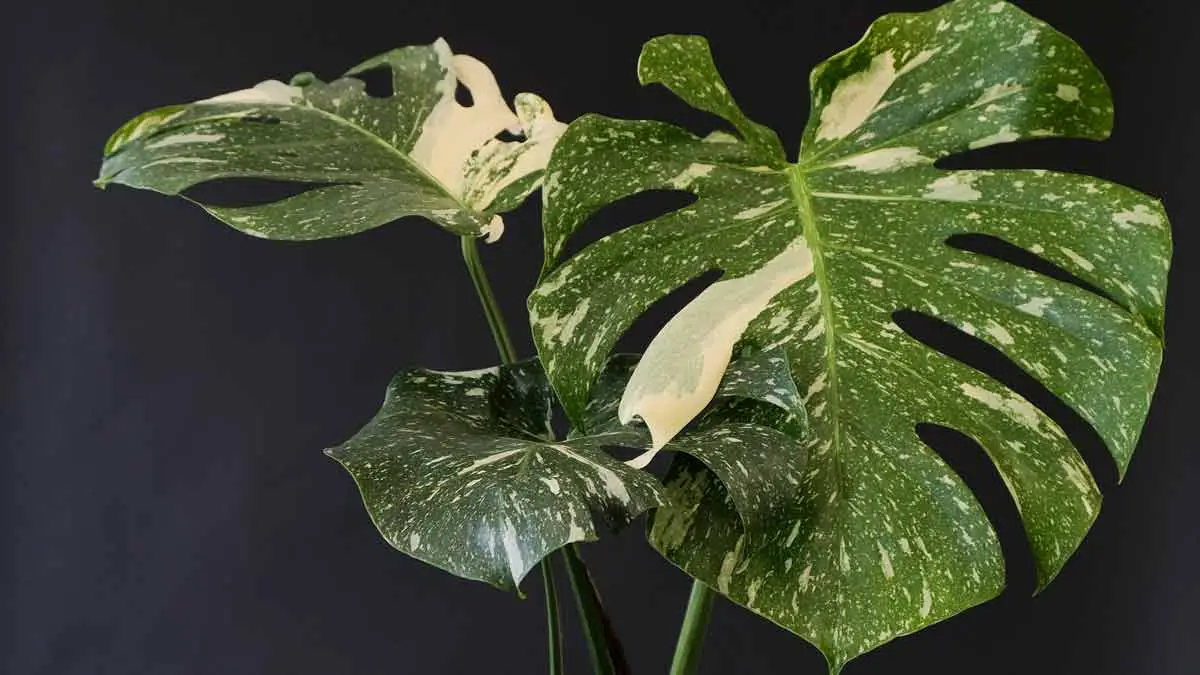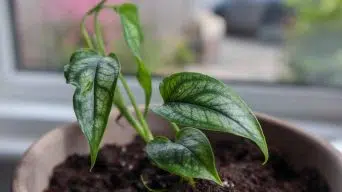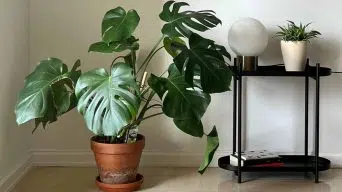Welcome to the ultimate guide on Thai Constellation Monstera care, where we uncover the secrets to nurturing this stunning variegated tropical plant.
You’ll learn about keeping your prized Monstera healthy and thriving, from ideal lighting and watering practices to dealing with common issues.
If you are a plant enthusiast who wants to master the art of caring for this eye-catching houseplant, keep reading as we dive deep into expert tips!
Overview Of The Thai Constellation Monstera
| Family: | Araceae |
| Genus: | Monstera |
| Botanical Name: | Monstera deliciosa Thai constellation |
| Common Names: | Monstera Thai Constellation, Thai Monstera |
| Origin: | Thailand |
| USDA Hardiness Zones: | 10 – 13 |
| Size: | 8 feet tall (2.5 m) |
| Sun Exposure: | Bright indirect light |
| Water Needs: | Lightly moist but not wet |
| Soil Type: | Well-draining soil rich in organic matter |
| Temperature: | 64-86˚F (20-30°C) |
| Humidity Levels: | 60% |
The Thai Constellation Monstera is a true showstopper in appearance, boasting creamy-white variegated leaves that capture the attention of any plant enthusiast.
The stunning foliage features an eye-catching blend of dark and light green hues punctuated by irregularly shaped splotches of white or cream.
Each leaf is uniquely different in its pattern and distribution of colors, making it a one-of-a-kind addition to your indoor garden.
One fascinating aspect of this beautiful plant is that the variegation on the leaves occurs naturally due to a genetic mutation rather than being caused by external factors such as sunlight exposure.
Despite mainly being grown for its attractive foliage, the Thai Constellation Monstera can also produce flowers similar to other members of the same genus.
These flowers develop into fruit resembling an ear of corn – giving yet another reason why this tropical plant has gained popularity among collectors and enthusiasts alike.
Growth Habits
The Thai Constellation Monstera is renowned for its vigorous growth habits, which make it an eye-catching and popular addition to any plant enthusiast’s collection.
This stunning variegated monstera variety displays a remarkable growth rate, often producing new foliage every month under optimal care conditions.
Within a year, these plants can quickly grow between 1-2 feet in height, making them an ideal choice for those seeking a statement piece for indoor greenery.
Native to Central and South America, the Monstera Thai Constellation thrives best in conditions that mimic its tropical origins.
You’ll soon witness its impressive development firsthand by providing your plant with bright indirect light and maintaining consistent watering practices.
Additionally, this spectacular houseplant flourishes when given ample support, such as stakes or trellises, due to the presence of aerial roots that sprout from the base of the stem as it matures—a trait common among Monsteras.
Be sure not to expose your Thai Constellation Monstera to direct sunlight, as this can lead to leaf burn or discoloration; instead, aim for dappled shade throughout the day, where possible.
With their rapid growth rate and striking variegated leaves that blend shades of green with creamy white patterns, there’s no doubt these plants have cemented themselves as must-have additions for gardeners and admirers alike.
By understanding their natural habitat preferences and adjusting our care routines accordingly, we set ourselves up for success when tending to our very own Thai Constellation Monstera plants.
Thai Constellation Monstera Care Guide
Learn everything you need to know about caring for your Thai Constellation Monstera, from sunlight and watering requirements to pruning and maintenance tips.
Read on to keep your plant healthy and thriving!
Sunlight And Light Requirements
One of the most crucial aspects of Thai Constellation Monstera care is providing the right amount of sunlight and light exposure for optimal growth.
This stunning variegated plant thrives in bright indirect light, which allows its gorgeous foliage to flourish without causing sunburn or scorching.
An ideal location for your Thai Constellation Monstera would be near a large window with filtered sunlight, ensuring it receives plenty of diffused illumination throughout the day.
However, remember that the variegated sections containing less chlorophyll cannot absorb sunlight as efficiently as their green counterparts.
In this regard, low-light conditions should be avoided because they can lead to elongation and poor development of leaves.
On the flip side, direct sun exposure must also be kept at bay since these delicate plants are not tolerant to strong rays that could cause irreversible damage to their appearance.
By balancing bright indirect light and avoiding direct sunlight exposure, you’ll set your Thai Constellation Monstera toward healthy growth filled with visually beautiful variegations.
Watering Needs
Thai Constellation Monstera requires consistent and moderate watering.
It is vital to ensure that the soil remains lightly moist at all times but not wet.
Overwatering should be avoided as it can lead to root rot, harming the plant severely.
While some plants may require a specific schedule for watering, Thai Constellation Monstera’s needs can vary depending on growing conditions and location.
In winter or colder months, it is best to reduce the watering frequency to prevent the oversaturation of water in the soil.
To check whether Thai Constellation Monstera requires proper hydration levels, assess the topsoil around it by touching and observing changes in color between dryness and moisture levels.
When watering your plant, use filtered water at room temperature so that no sudden fluctuations from cold water shock or hot weather temperatures could stress out the roots.
A pot with suitable drainage holes will allow excess water to drain freely from the soil without pooling under your plant’s roots.
Maintaining an adequate balance of moisture levels for your Thai Constellation Monstera is crucial for its growth and well-being.
Remember to monitor how often you’re watering it and avoid letting it dry out completely, as this leads to wilting leaves, while also avoiding overwatering that can cause root rot damage, leading to death if left unattended.
Soil Requirements
Choosing the right soil is important to keep your Thai Constellation Monstera healthy and thriving.
Good drainage should be the top priority when selecting soil for this plant. Soggy potting mix can cause root rot, a common issue that plagues many plant species.
Add perlite or sand to the potting mix to improve drainage.
When planting your Monstera in a new pot, ensure it has enough space for roots to spread out comfortably.
If you prefer organic materials, you can use sphagnum moss or coco coir as an alternative to standard potting mix.
Remember that high-quality well-draining potting soil can work well for this exotic tropical plant.
Optimal Temperature And Humidity Levels
The Monstera Thai Constellation plant thrives in a temperature range of 20-30 °Celsius (64-86˚F).
This tropical beauty requires warm and humid conditions to prosper, much like its native habitat in Central and South America.
To ensure the plant’s health, maintain temperatures between 64-86˚F and humidity levels above 60%.
You can achieve this by using a humidifier or placing a tray filled with pebbles and water under the pot.
The Thai Constellation Monstera is sensitive to extreme heat, cold drafts, and low humidity levels.
Be cautious not to expose the plant to direct sunlight as it may scorch or damage its variegated leaves.
If your home has dry air or low ambient moisture, you can create a microclimate around the plant by misting it regularly with room-temperature distilled water or placing it near other plants that produce moisture.
Fertilizing And Nutrient Requirements
One of the critical aspects of Thai Constellation Monstera care is proper fertilization and nutrient requirements.
During the growing season (Spring/Summer), it’s essential to moderately feed your plant with an indoor plant fertilizer every 4-6 weeks.
Proper feeding ensures the plant grows well and develops its characteristic variegation.
When choosing a fertilizer for your Thai Constellation Monstera, opt for one with higher nitrogen levels than phosphorus or potassium.
A balanced, water-soluble fertilizer with micronutrients such as iron will be ideal.
You can also use organic fertilizers like compost or worm castings to provide your plant with the required nutrients without harming it.
Potting And Repotting Requirements
Potting and repotting are crucial for the health and growth of your Thai Constellation Monstera.
When choosing a new pot for your plant, it’s important to select one that is only one size larger than its current pot to avoid overpotting. Overpotting can lead to soil staying too moist, which can cause root rot.
Repotting should only be done when necessary, as the Thai Constellation Monstera prefers being slightly root-bound.
Signs that it’s time to repot include roots poking through drainage holes or if you notice the plant toppling over due to excess weight.
Repot in early spring using fresh soil while gently removing the old soil from around the roots before planting in the new pot.
Good drainage is critical in preventing root rot, so ensure adequate drainage with every repotting session.
Pruning And Maintenance Tips
Proper pruning and maintenance are essential for a healthy Thai Constellation Monstera plant.
Follow these tips to keep your plant in top shape:
- Remove any leaves that are brown, yellow, or damaged. This will help prevent the spread of disease and pests.
- Cut back any stems that are overgrown or leggy to encourage new growth.
- Use sharp, clean tools when pruning to avoid damaging the plant.
- Trim away aerial roots that have grown too long and become tangled or unsightly.
- Regularly dust and wipe down the leaves to keep them clean and debris-free.
- Monitor your plant’s growth and adjust watering and fertilizing as needed.
- Consider staking or propping up your Thai Constellation Monstera to support its weight as it grows larger.
Common Issues And Their Solutions
When caring for a Thai Constellation Monstera plant, it is common to encounter issues such as leaf discoloration, wilting, and pest infestations.
Additionally, root rot can be a significant problem if not addressed promptly.
Fortunately, various solutions are available to tackle these problems and help your plant thrive.
Understanding the common issues and their solutions can help you provide the best care for your Thai Constellation Monstera.
Pests And Diseases
Thai Constellation Monstera plants can be susceptible to pests and diseases, negatively affecting their health and appearance.
Here are some common issues and solutions:
- Scale – These tiny insects feed on the plant’s sap, causing yellowed leaves and stunted growth. Use insecticidal soap or neem oil to control them.
- Spider Mites – These tiny bugs can create webs on the leaves, causing brown spots and leaf drop. Keep the humidity levels high to deter them, or use an insecticidal soap.
- Mealybugs – These soft-bodied insects secrete a white waxy substance that can attract ants and cause leaf drop. Wipe them off with a cloth soaked in rubbing alcohol or use insecticidal soap.
- Leaf Spot Disease – This fungal disease causes brown spots on the leaves and may lead to defoliation. Reduce watering and improve air circulation to prevent it.
- Root Rot – This condition is caused by overwatering and can lead to wilting, yellow leaves, and plant death. Ensure proper drainage and avoid letting the soil stay wet for too long.
Regularly inspecting your Monstera plant for signs of pests or disease is crucial to maintaining its health.
Preventive measures such as controlling humidity levels, avoiding overwatering or fertilizing, and inspecting new plants before bringing them home can help keep your plant healthy for years.
Leaf Discoloration
Leaf discoloration is a common issue that many plant enthusiasts face when caring for their Thai Constellation Monstera.
The presence of brown patches on the leaves may suggest insufficient watering or humidity, the presence of pests, or the occurrence of a disease.
Meanwhile, yellowing leaves may be caused by overfertilization, lack of nutrients, disease, or pest problems.
To prevent leaf discoloration and keep your plant healthy and vibrant, ensure you’re providing adequate water and humidity levels.
Adjust fertilization as necessary and regularly inspect for any sign of pests or diseases.
Additionally, try not to move your Thai Constellation Monstera too often, as even slight changes in light exposure can stress out the plant causing leaf discoloration.
If you notice brown spots or yellowing leaves early on, treat them immediately with appropriate measures such as fixing the underlying cause, like adjusting watering schedules and using pest control treatment if necessary.
Wilting And Drooping Leaves
Wilting and drooping leaves are common problems faced by Thai Constellation Monstera owners.
There can be various reasons behind this issue, including underwatering, lighting problems, fertilizer issues, transplant stress, temperature stress, pests, and diseases.
Addressing the underlying cause of wilting and drooping leaves is essential before the problem worsens.
One reason for wilting plants could be underwatering, which causes dehydration.
On the other hand, overwatering can lead to root rot and wilted leaves.
Checking soil moisture levels using a moisture meter or sticking your finger two inches deep into the soil helps determine when to water your plant again.
Another reason that may cause leaf discoloration could be incorrect light intensity.
Too much direct sunlight can burn monstera leaves, while too little indirect light may stunt growth or develop long stems.
Place your Thai Constellation Monstera near a window with bright indirect light (not direct sun) for optimal growth results.
Root Rot
Root rot is a common issue that Thai Constellation Monstera plant owners face.
It occurs when too much moisture in the soil leads to an anaerobic environment that promotes fungal growth.
Signs of root rot include wet and smelly soil, leaves turning yellow or brown, and falling off.
Prevention is critical to avoiding this problem. Keeping the soil moist but not soggy helps prevent root rot from taking hold.
A high-quality indoor potting mix with bark can also help avoid root rot.
The bark improves soil drainage and allows air circulation around the roots.
In addition, planting your Thai Constellation Monstera in a container with good drainage holes ensures excess water can escape rather than accumulate at the bottom of the pot.
You can keep your beautiful variegated Monstera healthy and thriving for years by paying attention to watering habits and providing appropriate growing conditions.
If you notice any signs of root rot in your Thai Constellation Monstera plant, it’s essential to act quickly before it spreads further into other parts of the plant or surrounding plants nearby if kept together.
Remove any damaged roots as much as possible, then let them dry for a few days before replanting them back into fresh soil, free from any pests or pathogens that may have been present previously.
Final Thoughts
If you’re a plant enthusiast looking to add a tropical flair to your collection, the Thai Constellation Monstera is an excellent choice.
This plant will make a statement in any room with its stunning variegated leaves and impressive growth habits.
Remember to provide it with plenty of bright indirect light, adequate humidity levels, and well-draining soil.
Regular watering and proper fertilization will keep it thriving for years to come.
With our ultimate care guide and tips for healthy growth, you’ll be able to enjoy the beauty of this unique plant while providing it with everything it needs to flourish.
Happy growing!







